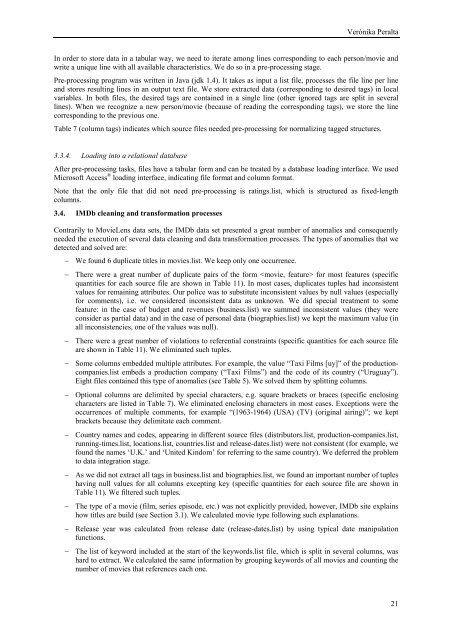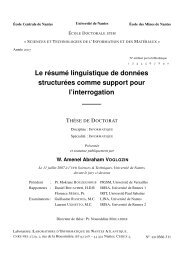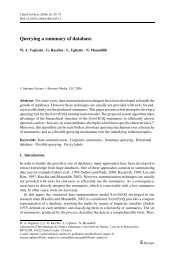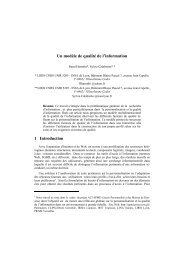Extraction and Integration of MovieLens and IMDb Data - APMD
Extraction and Integration of MovieLens and IMDb Data - APMD
Extraction and Integration of MovieLens and IMDb Data - APMD
Create successful ePaper yourself
Turn your PDF publications into a flip-book with our unique Google optimized e-Paper software.
Verónika Peralta<br />
In order to store data in a tabular way, we need to iterate among lines corresponding to each person/movie <strong>and</strong><br />
write a unique line with all available characteristics. We do so in a pre-processing stage.<br />
Pre-processing program was written in Java (jdk 1.4). It takes as input a list file, processes the file line per line<br />
<strong>and</strong> stores resulting lines in an output text file. We store extracted data (corresponding to desired tags) in local<br />
variables. In both files, the desired tags are contained in a single line (other ignored tags are split in several<br />
lines). When we recognize a new person/movie (because <strong>of</strong> reading the corresponding tags), we store the line<br />
corresponding to the previous one.<br />
Table 7 (column tags) indicates which source files needed pre-processing for normalizing tagged structures.<br />
3.3.4. Loading into a relational database<br />
After pre-processing tasks, files have a tabular form <strong>and</strong> can be treated by a database loading interface. We used<br />
Micros<strong>of</strong>t Access ® loading interface, indicating file format <strong>and</strong> column format.<br />
Note that the only file that did not need pre-processing is ratings.list, which is structured as fixed-length<br />
columns.<br />
3.4. <strong>IMDb</strong> cleaning <strong>and</strong> transformation processes<br />
Contrarily to <strong>MovieLens</strong> data sets, the <strong>IMDb</strong> data set presented a great number <strong>of</strong> anomalies <strong>and</strong> consequently<br />
needed the execution <strong>of</strong> several data cleaning <strong>and</strong> data transformation processes. The types <strong>of</strong> anomalies that we<br />
detected <strong>and</strong> solved are:<br />
− We found 6 duplicate titles in movies.list. We keep only one occurrence.<br />
− There were a great number <strong>of</strong> duplicate pairs <strong>of</strong> the form for most features (specific<br />
quantities for each source file are shown in Table 11). In most cases, duplicates tuples had inconsistent<br />
values for remaining attributes. Our police was to substitute inconsistent values by null values (especially<br />
for comments), i.e. we considered inconsistent data as unknown. We did special treatment to some<br />
feature: in the case <strong>of</strong> budget <strong>and</strong> revenues (business.list) we summed inconsistent values (they were<br />
consider as partial data) <strong>and</strong> in the case <strong>of</strong> personal data (biographies.list) we kept the maximum value (in<br />
all inconsistencies, one <strong>of</strong> the values was null).<br />
− There were a great number <strong>of</strong> violations to referential constraints (specific quantities for each source file<br />
are shown in Table 11). We eliminated such tuples.<br />
− Some columns embedded multiple attributes. For example, the value “Taxi Films [uy]” <strong>of</strong> the productioncompanies.list<br />
embeds a production company (“Taxi Films”) <strong>and</strong> the code <strong>of</strong> its country (“Uruguay”).<br />
Eight files contained this type <strong>of</strong> anomalies (see Table 5). We solved them by splitting columns.<br />
− Optional columns are delimited by special characters, e.g. square brackets or braces (specific enclosing<br />
characters are listed in Table 7). We eliminated enclosing characters in most cases. Exceptions were the<br />
occurrences <strong>of</strong> multiple comments, for example “(1963-1964) (USA) (TV) (original airing)”; we kept<br />
brackets because they delimitate each comment.<br />
− Country names <strong>and</strong> codes, appearing in different source files (distributors.list, production-companies.list,<br />
running-times.list, locations.list, countries.list <strong>and</strong> release-dates.list) were not consistent (for example, we<br />
found the names ‘U.K.’ <strong>and</strong> ‘United Kindom’ for referring to the same country). We deferred the problem<br />
to data integration stage.<br />
− As we did not extract all tags in business.list <strong>and</strong> biographies.list, we found an important number <strong>of</strong> tuples<br />
having null values for all columns excepting key (specific quantities for each source file are shown in<br />
Table 11). We filtered such tuples.<br />
− The type <strong>of</strong> a movie (film, series episode, etc.) was not explicitly provided, however, <strong>IMDb</strong> site explains<br />
how titles are build (see Section 3.1). We calculated movie type following such explanations.<br />
− Release year was calculated from release date (release-dates.list) by using typical date manipulation<br />
functions.<br />
− The list <strong>of</strong> keyword included at the start <strong>of</strong> the keywords.list file, which is split in several columns, was<br />
hard to extract. We calculated the same information by grouping keywords <strong>of</strong> all movies <strong>and</strong> counting the<br />
number <strong>of</strong> movies that references each one.<br />
21







